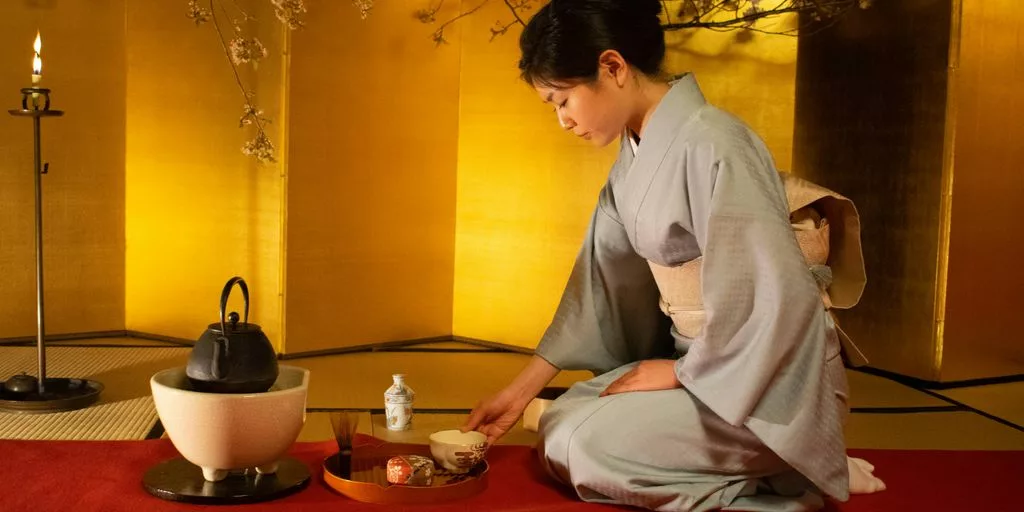
Historical Origins and Evolution
Early Beginnings in the 9th Century
The Japanese Tea Ceremony traces its roots back to the 9th century CE. The first recorded instance involves a Buddhist monk named Eichu, who introduced tea preparation to Japan. This practice began to influence meditation among Chinese Buddhist monks, laying the groundwork for what would become a deeply spiritual and cultural tradition.
Zen Buddhist Influences
The ceremony underwent significant changes thanks to Zen Buddhist monk Murata Juko. His contributions helped shape the tea ceremony into a meditative practice, emphasizing simplicity and mindfulness. This period marked the unearthing of the connection between tea and Zen philosophy, making the ceremony a spiritual journey rather than just a social event.
16th Century Developments
By the 16th century, the Japanese Tea Ceremony had evolved into an elite artistic pursuit. It became a hallmark of refinement and sophistication among the ruling class. This era saw the tea ceremony being revered not just for its aesthetic beauty but also for its role in daily life, reflecting a deep reverence for beauty and simplicity.
Philosophical Foundations
Principles of Harmony and Respect
The Japanese tea ceremony is deeply rooted in the principles of harmony and respect. These values are not only central to the ceremony but also serve as a guide for life. The tea ceremony embodies the four principles of "Wa, Kei, Sei, Jaku" – Harmony, Respect, Purity, and Tranquility. These principles promote peace, mutual respect, and a deep appreciation for the beauty of the world.
The Concept of Wabi-Sabi
Wabi-Sabi is a Japanese philosophy that celebrates the beauty in imperfection. It emphasizes finding joy and contentment in simplicity and the natural world. This philosophy is particularly reflected in Japanese tea ceremonies, where the focus is on the ritual and experience of tea drinking rather than the tea itself. From the rustic pottery cups used to serve the tea to the deliberate, careful movements of the tea master as they prepare the tea, every aspect is designed to create a serene, mindful experience.
Spiritual Significance
The deliberate, mindful actions required in preparing and serving the tea mirror Zen practices, instilling a sense of calm and present awareness in both the host and the guest. This meditative aspect is a key component of the overall experience, transforming the tea ceremony from a simple act of hospitality into a profound spiritual ritual.
The philosophy of the tea ceremony offers a lens through which to view and experience life, and acts as a reminder to cherish each moment.
Ceremonial Elements and Etiquette
The importance of ceremony and etiquette goes beyond mere formalities; it encapsulates the values upheld by Japanese culture through generations. Each gesture embodies respect for history, artistry, and connection with others through shared experiences around a bowl of matcha.
The tea master orchestrates the entire ceremony, ensuring every movement is deliberate and meaningful. Their role is not just to serve tea but to create an atmosphere of tranquility and respect. The tea master embodies the ideals of the ceremony, guiding participants through a journey of mindfulness and appreciation.
The tea utensils used in the ceremony hold individual relevance. Every item, from the tea scoop to the tea whisk, has a specific purpose and requires careful handling and proper maintenance. Each utensil is treated with utmost respect, as it is an integral part of the ceremony. Their use and placement are dictated by age-old traditions that reinforce the importance of mindfulness and attention to detail.
- Kaiseki Meal: The host commences the ceremony with a traditional multi-course meal emphasizing seasonal ingredients.
- Serving the Tea: Post the meal, the tea is served, starting with the guest of honor.
- Admiring the Bowl: Each guest receives the tea bowl, admires its beauty, and then takes a sip.
- Passing the Bowl: The bowl is then passed on to the next guest in line, fostering a sense of community and respect.
By incorporating elements such as harmony (wa), respect (kei), purity (sei), and tranquility (jaku) into each movement or gesture during the ceremony, participants embrace an elevated level of consciousness that extends beyond just sipping tea; it fosters a deeper connection with oneself and one’s surroundings.
Aesthetics of the Tea Room and Garden
Design and Layout
The tea room is a masterpiece of minimalist elegance. Typically small and rustic, every decoration is chosen for its symbolic meaning. From the scroll on the wall to the flower arrangement, each element reflects the season and the host’s intentions. These details are not merely decorative but carry deep spiritual significance, echoing Zen Buddhist principles like simplicity and mindfulness.
Symbolic Elements
In the tea room, nothing is random. The hanging scrolls often showcase scenic landscapes or elegant calligraphy, while the flower arrangements, known as ikebana, are meticulously crafted to harmonize with the room’s ambiance. Incense jars add a subtle fragrance, enhancing the sensory experience.
Integration with Nature
The tea garden is a tranquil haven designed to encourage a calm spirit. Stones of varying shapes and sizes form the path leading to the teahouse, and a stone lantern is placed near a stone basin where visitors wash their hands before entering. The garden’s deliberate design invites guests to slow down, appreciate seasonal changes, and find peace amidst their surroundings.
The tea room and garden are not just spaces; they are immersive experiences that embody the essence of the Japanese tea ceremony.
Contemporary Relevance
The Japanese Tea Ceremony has seen a global resurgence. Its timeless elegance and profound cultural roots captivate people worldwide. This ancient tradition is more than just a ritual; it’s a bridge connecting the past with the present.
The ceremony’s meticulous nature and deep symbolism offer a unique way to experience mindfulness and cultural heritage.
Global Popularity
The Japanese Tea Ceremony is celebrated across continents. From tea houses in Kyoto to cultural festivals in New York, its influence is undeniable. This global embrace highlights the ceremony’s universal appeal and its ability to transcend cultural boundaries.
Modern Interpretations
Contemporary tea masters are blending tradition with innovation. They incorporate modern elements while respecting the ceremony’s core principles. This fusion creates a dynamic experience that resonates with today’s audience.
Cultural Preservation
The Japanese Tea Ceremony is a living tradition. Efforts to preserve it include educational programs, workshops, and cultural exchanges. These initiatives ensure that the essence of this ancient practice continues to thrive in modern society.
Health and Wellness Benefits

Mindfulness and Meditation
The Japanese tea ceremony is a deeply meditative practice that emphasizes mindfulness. This ritual encourages participants to be present in the moment, fostering a sense of inner peace and tranquility. The deliberate and slow movements during the ceremony help in grounding oneself, making it a perfect practice for those seeking mental clarity and emotional balance.
Physical Health Benefits
Japanese matcha tea, a staple of the tea ceremony, is packed with antioxidants. These powerful compounds can boost your immune system, improve gut health, and even lower the risk of heart disease. Additionally, matcha has shown potential in increasing metabolic rate and fat oxidation, making it a tantalizing ally in the quest for a healthier body.
Emotional Well-being
Engaging in the tea ceremony can be a nourishing experience for both the body and soul. The serene environment and the act of sharing tea with others foster a sense of community and belonging. This practice can significantly reduce stress levels and promote a balanced mood, contributing to overall emotional well-being.
The Japanese tea ceremony is more than just a ritual; it’s a holistic practice that nourishes the mind, body, and soul.
Conclusion
The Japanese tea ceremony is a timeless tradition that offers a profound glimpse into the cultural and philosophical essence of Japan. By embracing the principles of harmony, respect, purity, and tranquility, participants are invited to experience a deeper connection with themselves and their surroundings. This ritual, which transcends the simple act of drinking tea, serves as a bridge to understanding and appreciating the rich heritage and values of Japanese society. Whether you are a seasoned practitioner or a curious newcomer, the Japanese tea ceremony provides an enriching experience that continues to captivate and inspire people around the world.
Frequently Asked Questions
What is the Japanese tea ceremony?
The Japanese tea ceremony, also known as ‘chanoyu’ or ‘sado,’ is a traditional ritual influenced by Zen Buddhism that involves the ceremonial preparation and consumption of matcha, or powdered green tea.
What are the main principles of the Japanese tea ceremony?
The main principles of the Japanese tea ceremony are harmony (wa), respect (kei), purity (sei), and tranquility (jaku). These principles guide the actions and mindset of participants throughout the ceremony.
How did the Japanese tea ceremony originate?
The Japanese tea ceremony originated in the 9th century CE, with significant influences from Zen Buddhist monks such as Murata Juko in the 15th century and further developments in the 16th century.
What is the role of the tea master in the ceremony?
The tea master, or ‘chajin,’ is responsible for preparing the tea, guiding the guests through the ceremony, and ensuring that the principles of the tea ceremony are upheld. The tea master’s role requires extensive training and deep understanding of the ritual.
What are the health benefits of participating in a Japanese tea ceremony?
Participating in a Japanese tea ceremony can offer various health benefits, including mindfulness and meditation, which promote emotional well-being, as well as physical health benefits from the antioxidants found in matcha tea.
How is the tea room designed for the Japanese tea ceremony?
The tea room, or ‘chashitsu,’ is designed with simplicity and natural elements in mind, reflecting the aesthetic principles of wabi-sabi. It often includes a tokonoma (alcove) for art display, tatami mats, and a garden that integrates with the natural surroundings.






